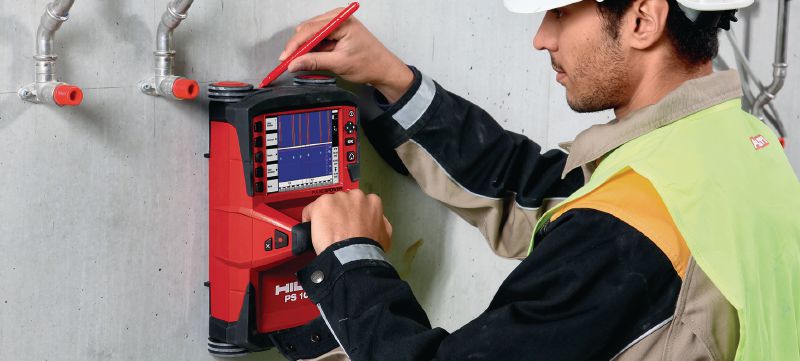Advanced RainierGPR Concrete Scanning Solutions Revealed
Wiki Article
Checking Out the Midst: A Comprehensive Overview to Concrete Scanning and Its Diverse Applications
In the world of construction and facilities growth, the thorough procedure of concrete scanning holds a crucial role in making sure the structural stability and safety and security of tasks. As modern technology continues to develop, the applications of concrete scanning have increased much past simple surface-level evaluations.Value of Concrete Scanning
Recognizing the significance of concrete scanning is critical in guaranteeing the security and stability of structures throughout construction and renovation projects. Concrete scanning utilizes innovative modern technologies such as ground-penetrating radar (GPR) and electromagnetic induction to discover ingrained items, spaces, or various other abnormalities within concrete frameworks - RainierGPR Concrete Scanning. By carrying out detailed scans before exploration, reducing, or coring into concrete, construction groups can avoid accidental damage to vital structural elements like rebar, conduits, or post-tension cables. This aggressive approach not only prevents pricey fixings and job hold-ups however likewise enhances total construction security by mitigating the threat of architectural failures or collapses as a result of compromised honesty.Additionally, concrete scanning plays a pivotal duty in making certain compliance with building codes and guidelines that mandate the defense of existing architectural elements throughout construction tasks. By accurately mapping out the interior composition of concrete, scanning innovations make it possible for construction experts to make enlightened decisions that promote the structural security and durability of buildings and framework projects. Fundamentally, the significance of concrete scanning depends on its capacity to protect both the architectural stability and the employees associated with building and construction endeavors.
Technologies Made Use Of in Concrete Scanning
Concrete scanning counts on innovative technologies such as ground-penetrating radar (GPR) and electro-magnetic induction to precisely spot embedded objects and anomalies within concrete structures. Ground-penetrating radar operates by emitting high-frequency electro-magnetic waves right into the concrete.Electro-magnetic induction, on the various other hand, works by producing electro-magnetic fields around a concrete structure through a transmitter coil. When steel items exist within the concrete, they interfere with these electro-magnetic areas, causing eddy currents to move via the steel. By determining the changes in the electromagnetic areas with a receiver coil, the system can determine the place of metal things in the concrete.
These sophisticated modern technologies play a crucial duty in non-destructive testing, guaranteeing the safety and stability of concrete structures in different sectors.
Applications in Building And Construction Market
Within the construction industry, concrete scanning innovation locates varied applications that boost task performance and security. In addition, concrete scanning is made use of for finding spaces, such as air pockets or locations of deterioration within concrete, which can compromise the overall strength of a framework. Concrete scanning plays a crucial role in quality control by verifying the thickness of concrete covers over support, guaranteeing compliance with design specifications and criteria.
Safety Advantages of Concrete Scanning
In the realm of building safety, the implementation of concrete scanning innovation provides a critical advantage in preemptively recognizing prospective threats and fortifying structural honesty. By utilizing advanced scanning approaches such as ground-penetrating radar (GPR) and electromagnetic induction, building and construction teams can precisely situate rebar, post-tension cables, conduits, and other surprise objects within concrete structures. This positive technique substantially reduces the risk of unexpected strikes throughout exploration, cutting, or coring tasks, therefore protecting against costly damages, injuries, and job hold-ups.In addition, concrete scanning improves worker safety and security by supplying real-time info regarding the structural problem of concrete aspects. By dealing with possible safety and security issues quickly, concrete scanning adds to producing a safe functioning environment and alleviating the probability of structural failures or crashes on building and construction sites.
Future Fads in Concrete Scanning
Emerging improvements in scanning modern technology are poised to revolutionize the field of concrete inspection and analysis. By taking advantage of the power of AI, these systems can analyze substantial quantities of information accumulated throughout scanning procedures to provide more in-depth and precise insights into the condition of concrete structures.Another significant fad is the development of more user-friendly and mobile scanning tools. Miniaturization of scanning devices permits less complicated accessibility to confined spaces and remote places, making assessments much more detailed and effective. Furthermore, innovations in cordless communication technologies enable like this real-time data transfer and evaluation, assisting in quicker decision-making processes.
In addition, there advice is an expanding concentrate on sustainability in concrete scanning innovations - RainierGPR Concrete Scanning. Producers are increasingly including eco-friendly products and energy-efficient functions into their tools to decrease environmental influence. These future patterns are readied to enhance the efficiency, accuracy, and sustainability of concrete scanning practices, forming the market's future landscape
Conclusion
Finally, concrete scanning plays a crucial duty in the building sector by making sure the safety and efficiency of numerous jobs. By using advanced technologies, such as GPR and radar imaging, specialists are able to properly discover prospective risks within concrete frameworks. The applications of concrete scanning are large and remain to develop, making it an important tool for maintaining the stability of structures and infrastructure. As modern technology advances, the future of concrete scanning holds appealing developments for boosting construction procedures.

Report this wiki page